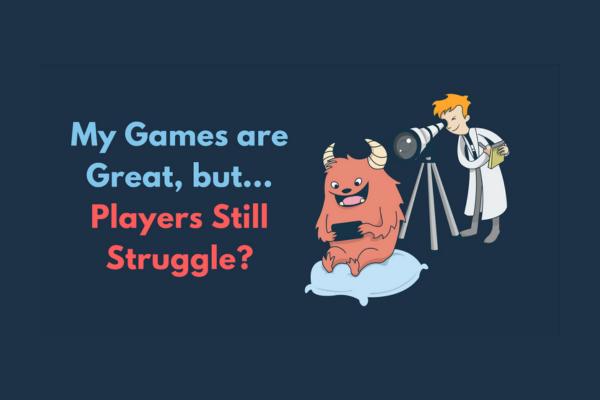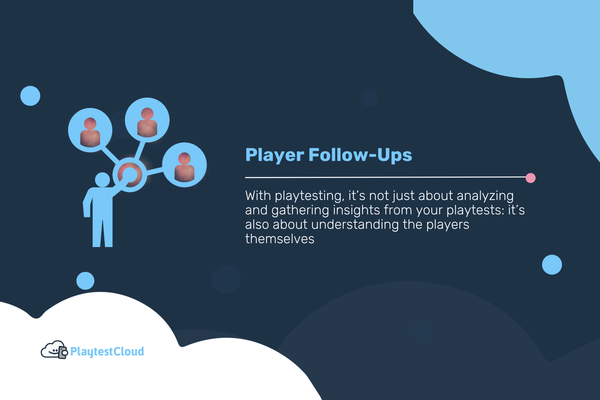Humans are complicated and unpredictable creatures. Have you ever tried to organize a group event and halfway through the planning decide it's almost not worth the effort? You're not alone. We can be so unpredictable that we ourselves don't know what we want until we have a decision to make and are forced to confront the essential humanness of preference.
We're not like this because we enjoy causing problems for others, but rather because we're complex. We all have our unique likes and dislikes, tendencies, schedules, aspirations, and so on – and these individual traits affect how we experience video games too.
My games are great, but players still struggle?
There's no magic formula for creating games that players will understand as the game designers intend. Sometimes players need more instructions, and sometimes the game needs to change. If players struggle no matter what instructions they are given, then it’s time to consider the human behind the screen a little more closely. This isn't a hopeless situation, though. This is where games user research can help.
What is games user research? "The primary function of games user research is, simply put, to test and evaluate the viability of the design with the ultimate goal of helping to make more enjoyable games," writes Maurice Tan on Gamasutra. That article is a great overview of what games user research is, how it works, and how it can help you achieve the vision you have for your game.
It's so important to conduct games user research because of how diverse players are. Player diversity means there are many aspects to a game that can attract someone – the art style, intellectual property, and design are all examples of elements that help to create the feel of a game. But it doesn't matter if your game is one of the most beautiful on the market (looking at you No Man's Sky) if it's not well received upon release by the people who matter the most – the players.
It's too important to overlook
Games user research provides insight and feedback into how players interact with your game. When games user research is done properly, it offers a direct connection between you and the players. It gets your game into the hands of real people who play games like yours. What you do with the results is up to you, but there's no doubt that it can be the difference between informed decisions and shots in the dark.
Conducting user research is a constant challenge. Industries change and paradigms shift – and we too must adapt our methods and thoughts about what's possible and what's necessary. PlaytestCloud is a remote user testing platform built on the idea of adapting to the times. What's clear to us is that advancements in technology mean it's easier than ever – and therefore more essential than ever – to conduct proper user research so we can better understand what users think.
We believe that for testing your mobile games, our platform, PlaytestCloud, is the right solution for anyone who wants to test mobile games for iOS, Android, or any game designed to work in a web browser.
How PlaytestCloud can help
The biggest way PlaytestCloud can help any mobile or web-based game developer is by getting games into the hands of real players. PlaytestCloud provides studios, publishers and independent developers from all over the world access to real video and mic audio of players playtesting their games – never before has it been so easy to get direct access to player feedback. With PlaytestCloud you have many options for conducting user research, including surveys, multi-session playtests, longitudinal studies, and concepts tests. PlaytestCloud is available for people who want to do user research the right way – and we're always around to help if you need assistance or have questions.
Just last month, PlaytestCloud co-founder, Christian Ress, spoke at the Games User Research Summit in San Francisco with a group of leading industry experts about building lasting relationships with teams who only got a taste of user research once their project was already on fire. The title of the talk: "How to save the forest when all the trees are on fire," is a phrase that intends to evoke the feeling of being on the wrong path when it's already too late to do much about it. It's a situation that occurs most often when people don't stop and check to make sure the path they're on is still going in the direction they thought it was.
Resources
There are links throughout this post, so take a look back through the post if something caught your eye. Games User Research SIG (GUR) is also a great source of information, and we encourage you to take a look at the resources available on their website and on their YouTube channel.
Over the next four weeks, we'll explore a range of topics and stories from the playtesting, usability testing, and mobile games scene. You can sign up below to have our blog posts delivered directly to your inbox so that you'll never miss a story.
You can also always reach out to us with questions.
Also read...
- UX Walkthrough: Anatomy of a Usability Test in Video Games (Part-1) (LinkedIn Pulse)
- UX Walkthrough: Anatomy of a Usability Test in Video Games (Part-2) (Gamasutra)
- “Ahhhh! You’re Doing It Wrong!” (Handrail)
- 3 Steps Every Game Studio Should Know Before Launching (PlaytestCloud)







